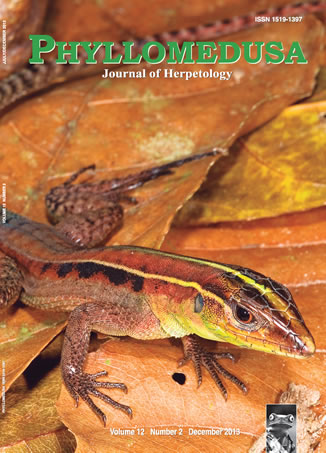Phenotypic plasticity in larval development and size at metamorphosis in Rhinella spinulosa (Anura: Bufonidae) from Salta, Argentina.
DOI:
https://doi.org/10.11606/issn.2316-9079.v12i2p117-124Keywords:
Body size, Development time, Metamorphosis, Parque Nacional Los Cardones.Abstract
Phenotypic plasticity typically is induced by environmental heterogeneity or stress, and is manifest by changes in behavior, morphology, or physiology. In amphibians, phenotypic variation is strongly influenced by the quality of the aquatic environment in wchich larvae develop. The stability of the aquatic environment and conspecific density are two important environmental stressors. We investigated whether larval populations of Rhinella spinulosa subject to varying levels of hydroperiod and intraspecific competition exhibit phenotypic plasticity in their life-history characteristics. Egg clutches were collected from an arid region, within Parque Nacional Los Cardones, Larvae were exposed to different levels of hydroperiod and conspecific density in the laboratory. Development time and size at metamorphosis were recorded. Our results show that larvae from different clutches respond in plastically in their life-history traits. Conspecific density was the most influential variable.Downloads
Download data is not yet available.
Downloads
Published
2014-02-10
Issue
Section
Articles
License
All material originally published in Phyllomedusa belongs to Escola Superior de Agricultura Luiz de Queiroz - Universidade de São Paulo. All contents are under a license of Creative Commons BY-NC-ND.How to Cite
Guantay, E. A., Acosta, N. R., & Núñez, H. A. (2014). Phenotypic plasticity in larval development and size at metamorphosis in Rhinella spinulosa (Anura: Bufonidae) from Salta, Argentina. Phyllomedusa: Journal of Herpetology, 12(2), 117-124. https://doi.org/10.11606/issn.2316-9079.v12i2p117-124



 Impact Factor (JCR): 0.600
Impact Factor (JCR): 0.600 CiteScore: 1.0
CiteScore: 1.0